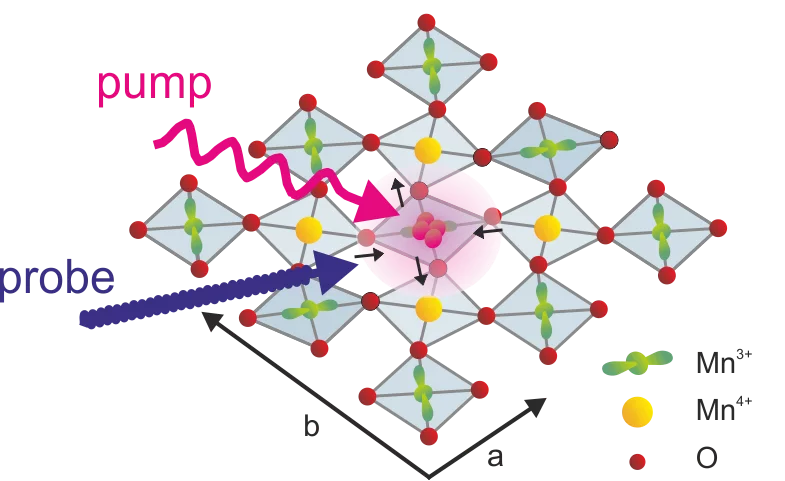The exploration of the interaction of structural and electronic degrees of freedom in strongly correlated electron systems on the femtosecond time scale is an emerging area of research. One goal of these studies is to advance our understanding of the underlying correlations, another to find ways to control the exciting properties of these materials on an ultrafast time scale. So far a general model is lacking that provides a quantitative description of the correlations between the structural and electronic degrees of freedom.
Here we investigate a perovskite-type manganite, a prototypical example of a strongly correlated electron system which exhibits properties such as colossal magnetoresistance and insulator-to-metal transitions that are intrinsically related to symmetry changes of the atomic lattice and to intriguing ordering patterns of the spins, orbitals and charges. The application of an ultrashort optical pulse melts the electronic order and launches a structural phase transition. The long-range electronic and atomic order during the transition is probed directly with time-resolved resonant x-ray diffraction. Although the actual change in crystal symmetry associated with this transition occurs over different time scales characteristic of the many electronic and vibrational coordinates of the system, we find that the dynamics of the phase transformation can be well described using a single time-dependent order parameter that drives the electronic phase transition as well as the coherent motion of the atomic lattice. We hope that this concept is applicable to the general case.
Here we investigate a perovskite-type manganite, a prototypical example of a strongly correlated electron system which exhibits properties such as colossal magnetoresistance and insulator-to-metal transitions that are intrinsically related to symmetry changes of the atomic lattice and to intriguing ordering patterns of the spins, orbitals and charges. The application of an ultrashort optical pulse melts the electronic order and launches a structural phase transition. The long-range electronic and atomic order during the transition is probed directly with time-resolved resonant x-ray diffraction. Although the actual change in crystal symmetry associated with this transition occurs over different time scales characteristic of the many electronic and vibrational coordinates of the system, we find that the dynamics of the phase transformation can be well described using a single time-dependent order parameter that drives the electronic phase transition as well as the coherent motion of the atomic lattice. We hope that this concept is applicable to the general case.
Original Publication
Published 3 August 2014 in Nature MaterialsDOI: 10.1038/nmat4046
Contact
Dr. Paul BeaudPaul Scherrer Institut, Switzerland
E-Mail: paul.beaud@psi.ch
